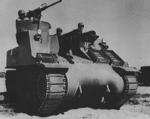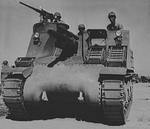M7 Priest
| Country | United States |
| Primary Role | Self-Propelled Gun |
Contributor: C. Peter Chen
ww2dbaseThe 105-millimeter Howitzer Motor Carriage M7 self-propelled artillery vehicles were built on the M3 Lee medium tank chassis; the decision for using the M3 medium tank chassis was from past experience that ground operations require adequate firepower from fully-tracked vehicles in addition to tanks. The superstructures were open-topped to allow being equipped with the large-caliber howitzers. They were accepted in Feb 1942 and production began in Apr 1942. In Sep 1943, the M7B1 variant design was completed; the major different between the original M7 and the new M7B1 design was that the latter used the chassis of M4 Sherman tanks. M7B1 variant design was declared the standard design in Jan 1945.
ww2dbaseLater in 1942, 90 M7 vehicles were transferred to the British forces in North Africa, where they were nicknamed "Priest" for the pulpit-like machine gun rings. They first saw combat during the Second Battle of El Alamein, where they fought with effectiveness, leading to the British requesting the United States for 5,500 more units (which was never completely fulfilled by the end of the war) despite the fact that they use American ammunition and must be supplied separately. After the introduction of the Canadian-built Sexton self-propelled artillery in 1944, which used British ammunition to ease logistics, 102 of the British M7 Priest vehicles were converted between Oct 1944 and Apr 1945 into Kangaroo armored personnel carriers capable of carrying 20 passengers and a crew of two.
ww2dbaseThe United States Army assigned M7 self-propelled artillery vehicles to every armored division, each operating three battalions of M7 vehicles. The great number of M7 vehicles provided very effective mobile artillery support for the Allied troops as they moved eastward toward and into Germany.
ww2dbaseDonald Bennett, an artillery officer in the US Army during WW2, noted his liking for the M7 self-propelled guns in his memoir.
ww2dbaseAfter WW2, M7 self-propelled artillery vehicles remained in service, participating in conflicts such as the Korean War. Overall, 3,490 M7 vehicles were built.
ww2dbaseSources: Honor Untarnished, Wikipedia.
Last Major Revision: Jan 2009
SPECIFICATIONS
M7
| Machinery | One Continental R-975 C1 rated at 340hp or 400hp |
| Suspension | Vertical Volute Spring Suspension |
| Armament | 1x105 mm M1/M2 Howitzer (69 rounds), 1x .50cal machine gun |
| Armor | 51mm |
| Crew | 7 |
| Length | 6.02 m |
| Width | 2.87 m |
| Height | 2.95 m |
| Weight | 22.0 t |
| Speed | 24 km/h off-road; 39 km/h on-road |
| Range | 193 km |
Photographs
 |  |
Please consider supporting us on Patreon. Even $1 per month will go a long way! Thank you. Please help us spread the word: Stay updated with WW2DB: |
Visitor Submitted Comments
All visitor submitted comments are opinions of those making the submissions and do not reflect views of WW2DB.

- » Wreck of Teruzuki Found (27 Jul 2025)
- » USS Orlean's Bow Found (22 Jul 2025)
- » The Emperor of Japan Planned to Honor WW2-era Japanese POWs in Mongolia (4 Jul 2025)
- » US State Lawmaker John Winter Caught Using Racial Slur "Jap" and Apologized (11 Jun 2025)
- » US Government Plans to Purge WW2 Information (17 Mar 2025)
- » See all news
- » 1,181 biographies
- » 337 events
- » 45,115 timeline entries
- » 1,248 ships
- » 350 aircraft models
- » 207 vehicle models
- » 376 weapon models
- » 123 historical documents
- » 261 facilities
- » 470 book reviews
- » 28,411 photos
- » 365 maps
General Douglas MacArthur at Leyte, 17 Oct 1944
12 Dec 2009 04:48:25 AM
My Father, Staff Sergeant Donald C. Boyd, also served with the 32nd "Red Arrow" Division, 128th Infantry Regiment, Cannon Company. He fought on Leyte, Luzon, the Druiniumor River, and the Villa Verde Trail where he drove an M7 Priest, carried an M1 Garand, and was awarded the Bronze Star for heroism. He is currently recovering nicely at home in Swanton, Ohio from recent triple bypass surgery. A short interview and recent images of my remarkable Dad may be viewed at this link. http://carol_fus.tripod.com/army_hero_donald_boyd.html